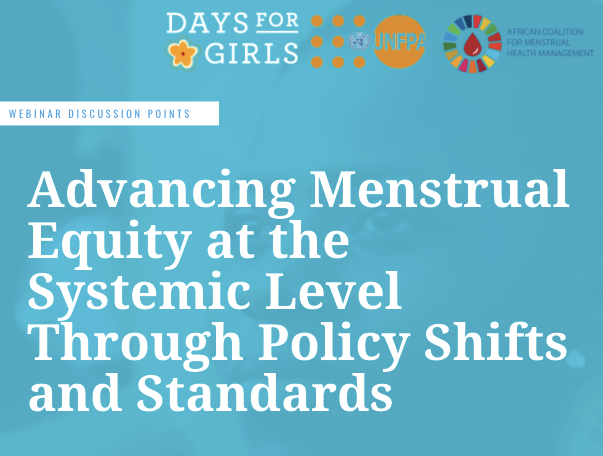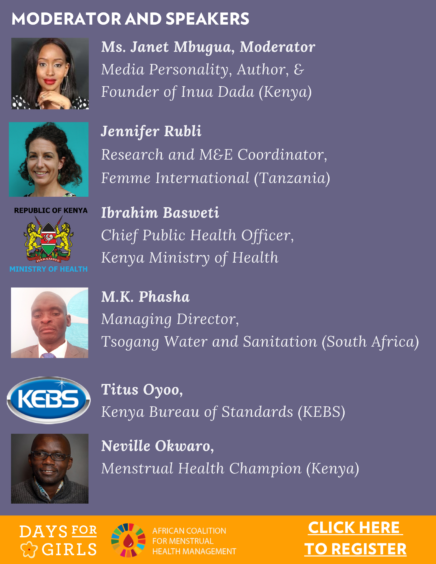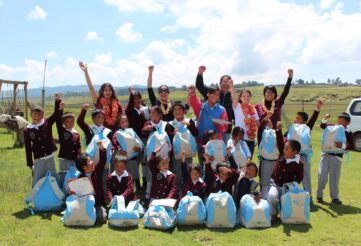Webinar Report: Advancing Menstrual Equity at the Systemic Level Through Policy Shifts and Standards

Although the Covid-19 pandemic continues to halt many in-person events, conversations on the future of MHM continue through virtual platforms. On February 25th, a number of regional experts came together to discuss menstrual equity at the systemic level. The event was sponsored by Days for Girls, UNFPA ESARO (East & Southern Regional Office), and the African Coalition for Menstrual Health Management (ACMHM), with IMHER as an honorary cosponsor. The webinar explored the opportunities and challenges of addressing menstrual equity in East and Southern Africa through advocacy work and policy change.
From considering the role of government at the macro-level in setting national agendas, to the specifics of what it means to design a building that sets standards for gender-inclusivity, panelists each contributed to a dynamic conversation on how to advance menstrual equity through policy shifts and standards. While the regional focus was Africa, most of the key takeaways from the session will resonate globally.
The link to the recorded session is available here.

Below are six key ideas that emerged from the discussion.
1. Faster progress is possible when ownership of MHM policy comes from the highest levels of government.
Many of the speakers, including Ibrahim Basweti, Kenya’s Senior Public Health Officer at the Ministry of Health, and Janet Mbuguya, the panel moderator, echoed the sentiment that strong and effective policy set at the highest levels of government translates to more equitable policies and practices on the ground.
Basweti spoke of the implications of establishing legal and regulatory frameworks that include monitoring, evaluation, research, and feedback frameworks at the national level so that equitable policies can be established.
In addition, policy shifts and government action on the national stage provide both a model and a precedent, helping to facilitate and expedite strong policies at the regional and local levels.
2. Participatory policy development processes at both the national and sub-national levels is key to policy success
Neville Okwaro, a consultant to Kenya’s Ministry of Health, stated the importance of engaging local and regional leaders throughout every step of the policy and decision-making process. This, he stated, can help ensure participation and adherence to MHM related policies on the sub-national level as well as create stronger national policies. While this means policies may take longer to design and implement, the policies established will better reflect and support the needs of all.
Additionally, establishing policies at regional and local levels of government will help to assure increased support, accountability, and buy-in to regulatory mechanisms such as disposable and reusable menstrual pad standards.
3. Increased attention to the design and quality of MHM products and infrastructure highlight these tangible components as essential to the advancement of menstrual equity
Titus Oyoo of Kenya’s Bureau of Standards (KEBS) stated in the session that quality control is one of the largest concerns of consumers and is something that requires government facilitation.
With respect to infrastructure, Kenny Pasha, the Managing Director for Water and Sanitation for South Africa, pointed out that guidelines and regulations around facility design – especially regarding female friendly bathroom designs – can help to further MHM aims.
Additionally, regulations around intra-Africa trade may become increasingly relevant, as Africa-based manufacturers of disposable and reusable menstrual products seek to sell their goods elsewhere on the continent.
4. Data is expected by decision makers, but often lacking.
Political decision makers – even those who fully support menstrual health work – tend to expect data to demonstrate the value of potential interventions. The challenge is that the data needed to develop and establish equitable and effective policies is often lacking. Developing MH interventions, from both government and NGOs, should include monitoring and learning research mechanisms to show effective and scalable solutions with data to back their results.
5. MHM education policy must go beyond traditional curricula to resource and support inclusive, responsive teaching in both formal and informal educational settings
Some of the panelists pointed out that when MHM information is included in curricula, educators are often unprepared to teach the material. That is partly because educators themselves generally come from the same communities as the school children, and therefore often share the same menstrual taboos and stigmas. As such, these curricular gaps should be identified, and then partnerships with Ministries of Education developed, for joint educational design that includes effective teacher training prior to the start of any educational initiatives promoted by the government.
Additionally, speakers said that both formal and informal settings should ideally be utilized for MHM education. While school curricula are regulated by government agencies and thus tend to be prime spaces for effective systemic change, religious and other community leaders should also be engaged in MHM work in order to bring MHM education not just to the classroom but to the entire community.
6. Funding is needed now more than ever.
MHM programming has been disrupted in many places around the world due to increased operating costs, decreased funding, and disruptions to existing systems such as in-person schools. As a result, many think that menstrual needs may be higher than before (#PeriodsDontStopForPandemics).
Jennifer Rubli from Femme International pointed out that COVID-19 shut down funding for essential and primary services in Tanzania, leaving much of menstrual programming in a lurch.
Many MHM organizations look to government and private sources to increase funding for MHM, but it is equally important for these organizations to look for opportunities to fund MH work through integration of MHM programming into existing sectors that are more well resourced, like humanitarian aid, or WASH. Mr. Pasha was able to do this with his female friendly toilets that were designed to meet the MH needs of the girls at school.
Reminders were provided that an increase in political and public visibility for MH-related work can be a critical route to bringing awareness to the issue and getting it on government agendas.
Other Topics
While the primary focus of the webinar was menstrual equity as it relates to broad policy shifts and systems building , speakers drew attention to a number of other issues during the call that represent specific policy and program focus areas that are often overlooked in MHM work: boys and men need to be included more in MHM discussions; differently-abled individuals need more support than they are getting; stigma issues need to be better addressed; and WASH infrastructure is key to supporting MHM.
Conclusion
With a range of perspectives and backgrounds, each panelist brought valuable ideas and perspectives on the strengths and challenges of MHM work in the policy and advocacy field. This webinar, and other similar virtual gatherings, facilitate important conversations and collaboration between NGOs, government officials, activists, and other stakeholders.
By sharing stories and experiences, important lessons can be learned about successful ways to advocate for MH while at the same time, learning areas for improvement as we work towards more equitable MHM outcomes in the policy field and beyond.
This webinar shined a light on the importance of having the highest levels of governments take ownership of MH to ensure faster progress is achieved. It also highlighted the need to advocate for subnational and national government leaders to work together in the development of policy so there is buy-in for the implementation. In addition, advocates must ensure MHM education policy is inclusive and reaches menstruators both in formal and informal education settings. Finally, we need to advocate for ways to increase attention on menstrual product standards to ensure the design and quality of menstrual products are safe for menstruators.
To continue learning ways you can advocate for menstrual equity through advocacy work and policy change, in your community or country please visit our menstrual health resource center.









